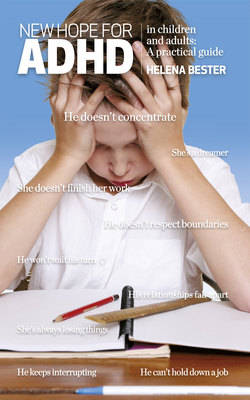Читать книгу New hope for ADHD in children and adults - Helena Bester - Страница 6
Introduction
ОглавлениеFor decades I worked almost exclusively with children with ADHD and their parents. ADHD, or attention deficit hyperactivity disorder, or attention deficiency, is characterised by one or more of the following main symptoms: inattention, hyperactivity and impulsivity. I conducted extensive research with a view to finding alternatives to the mainstream treatment, which was based mainly on prescribing stimulant medication.
Perhaps over time one develops a sixth sense pertaining to the subject to which one is dedicated. A veterinarian friend of mine who has performed thousands of sterilisations on animals, once told me she believes one perfects an action after ten thousand repetitions. Well, I may not have evaluated quite ten thousand ADHD cases, but I have consulted with and evaluated many over a period of many years. And yes, from the moment I set eyes on a client during a first consultation, my brain subconsciously begins to scan my extensive data base of stored facts for any of the subtle, often immeasurable hints in behaviour associated with ADHD. During the preliminary interview I have with the parents before I evaluate the child, I often recognise some signature ADHD-related signs or hints in one or even both parents.
The poem at the front of this book is about that immeasurable something that lies beyond reason and facts, and that encompasses the uniqueness of each individual. Even though I generalise a great deal in this book, I do realise with my entire heart, soul and understanding that you and your child are unique. I never reduce the person I am working with to the condition that brought them to me. But measurable or not, we must be able to clearly identify the signs, symptoms and tendencies in order to tackle the problem effectively, especially if it is hindering the person’s functioning.
Readers who have perhaps read one of my previous books or attended one of my talks or heard me on the radio, will know that I readily sing the praises of people with ADHD. They are usually very honest; they see only the good in others; they are extremely enthusiastic; and the hyperactive group provides the energy that drives progress. So why is it necessary to “cure” those with ADHD? Hasn’t it simply become fashionable to diagnose and treat every second person with attention deficit disorder – with or without hyperactivity? Are we focusing too much attention on this condition, which can potentially result in overdiagnosis? Shouldn’t we rather accept that people are different without labelling them? Aren’t we using our diagnoses and therapies to make people conform to the safe “known”? These are just a few of the valid questions that are examined in this book.
One of the new alternative treatments that we will look at in detail, is neurofeedback therapy. It is used for all forms of ADHD and, although less commonly, is also used very successfully in the treatment of anxiety disorders, insomnia, depression, epilepsy, brain injuries, autism, intermittent explosive disorder, and addiction. In fact, in October 2012 the American Academy of Pediatrics indicated the therapy as a level-1 treatment (that is, a preferred option in the proposed treatment protocol) and the best supporting therapy for attention-related problems. We will return to this later.
Since offering neurotherapy in my practice as a supplementary therapy, I am no longer focusing exclusively on the treatment of attention-related problems, but also on treating the conditions mentioned above. The difference this therapy makes to the lives of people, is something I am privileged to witness and one of the reasons for writing this book. I have included quotes from these people throughout the book – whether they themselves or their child has received the therapy.
It used to be believed that one outgrew ADHD. We now know that this is usually not the case. Some people develop the ability to manage the symptoms better, but this is not true for everyone. ADHD with or without hyperactivity in adults, another focus of this book, has a huge impact on one’s performance and relationships. Most sufferers over the age of thirty have never been diagnosed. Twenty years ago, the symptoms that teachers and parents now recognise as those of ADHD, were interpreted differently. The child was written off as naughty or lazy or stubborn. Often it is only years later, when the person’s own child is diagnosed with ADHD, that he realises he has the same problem.
Managing the symptoms associated with ADHD, whether in the case of an adult or a child, remains a source of concern eight years after publication of my previous book. Whatever treatment is followed, the sufferer must learn skills to prevent the symptoms taking over his life. At the same time, the parent must learn skills to support the child and the teacher, to make the necessary adjustments within the learning environment. Tips on how to do this are provided in this book.
I still firmly believe, as I wrote in the introduction to my previous book, that we are not defined by other people’s judgements or by a diagnosis. Our own fears are our only limitation. I also know that when we face our fears, the terror of those fears vanishes. Perhaps you have been struggling for years to hide or suppress the symptoms of attention deficit disorder or some other problem. I invite you to join me with an open mind on a journey to a possible solution.
The children and families referred to in this book are based on actual cases. Names and details have, however, been changed and some cases combined to ensure confidentiality.
